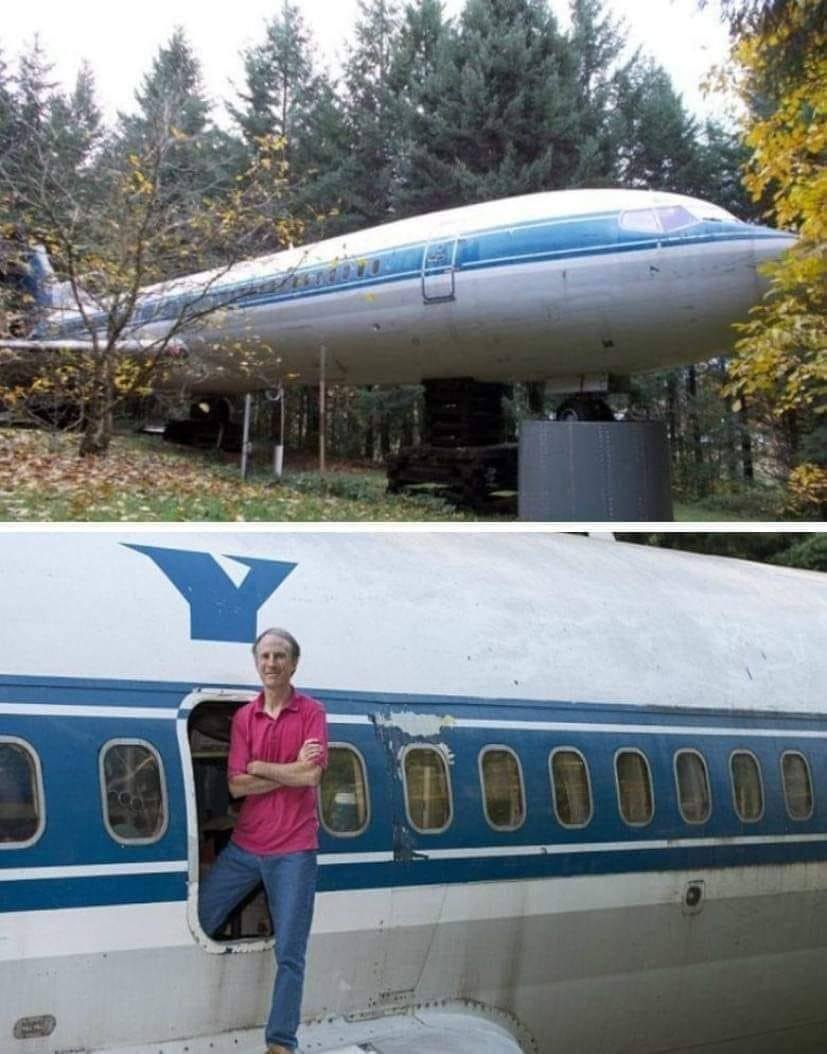At 64 years old, Bruce Campbell, a retired electrical engineer, has done something most people wouldn’t even dream of—he turned an old Boeing 727 airplane into his full-time home. It all began when he was in his early twenties and made a bold move to purchase a 10-acre wooded lot near Hillsboro, Oregon, for $23,000. While many young investors would have built a traditional house, Campbell had something far more imaginative in mind. His vision was always centered on innovation and rethinking the ordinary.

Originally, he planned to create a home from retired cargo ships, believing his idea was one-of-a-kind. However, nearly two decades later, he discovered that a woman named Joanne Ussery, a hairdresser from Mississippi, had done something similar by transforming a Boeing 727 into her riverside home after her house was lost in a fire. Inspired by her story, Campbell shifted gears and set his sights on giving new life to an old jetliner. In 1999, he purchased a retired Boeing 727 from Olympic Airways for $100,000. But buying the plane was just the start—the real challenge was getting it from Athens, Greece, to his property in Oregon. The cost of dismantling, shipping, and reassembling the plane added another $120,000 to the bill, bringing his total investment to $220,000. It was no small feat, but Campbell believed wholeheartedly in the value of repurposing the massive structure. For him, it wasn’t about having a fancy or luxurious place to live—it was about transforming a complex piece of engineering into a functioning, sustainable home that pushed the boundaries of traditional living. Once the aircraft arrived on his property, Campbell got to work converting it into a livable space.
He preserved much of the plane’s original interior, including the cockpit, lavatory, and some seating, while also installing a washing machine and a functional sink. Despite the vast interior of the jet, Campbell lives very simply. His kitchen setup consists of a microwave and toaster, and he typically eats basic meals such as cereal and canned food. The lifestyle might seem minimal to some, but it perfectly fits his philosophy of practical, intentional living. Walking into Campbell’s plane-home is like stepping into a futuristic sci-fi movie set. The aircraft’s original aluminum walls still shine, and the narrow corridors give it a sleek, industrial vibe that stands in sharp contrast to the forest surrounding it.
The cockpit, left largely untouched, serves as both a historical relic and a symbol of the plane’s previous life soaring through the skies. It’s this blend of preservation and innovation that makes his home so intriguing. What’s even more impressive is the fact that Campbell completed most of the transformation himself, driven by his passion for engineering and do-it-yourself projects. His unconventional home has attracted widespread attention from architects, adventurers, and curious onlookers around the world. While he doesn’t live there full-time anymore, he still spends a significant portion of his year in the aircraft and is immensely proud of the work he’s done. His project is more than a quirky experiment—it’s a statement about rethinking what a home can be and pushing past the limits of traditional architecture.
Campbell believes that repurposing retired planes could help reduce waste and even provide innovative housing solutions. And when you consider the durability and structural integrity of an aircraft, it starts to make sense. But perhaps the most fascinating part of this story is the emotional and philosophical angle. Waking up in the middle of a quiet Oregon forest inside a plane that once soared across the skies offers a surreal, almost dreamlike experience. The juxtaposition between the cold, streamlined metal and the lush greenery outside his windows creates a peaceful balance that many modern homes strive to replicate. Campbell’s vision is proof that with creativity, determination, and a willingness to break the mold, something extraordinary can be created from the seemingly obsolete. His story isn’t just about building a house—it’s about reshaping how we think about living spaces, sustainability, and the possibilities that lie in second chances for forgotten machines. His airplane home stands as a bold, beautiful reminder that home really can be wherever the heart—and the imagination—takes you.




